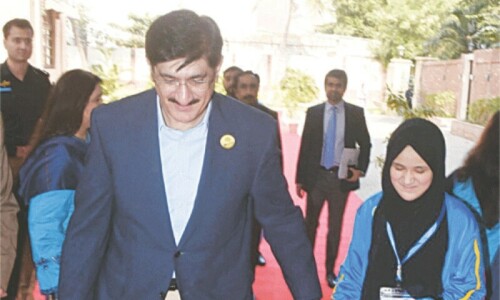 KARACHI, Sept 13: Perhaps due to the general disdain with which figurative art has been viewed in traditional Muslim societies, calligraphy has been an outlet for artists wishing to express themselves creatively ever since the advent of Islam. And as master calligraphers have proven over the centuries, this supposed handicap has been used to develop an art-form that mirrors the exquisite, sublime subtlety of the sacred verses calligraphers’ pens transcribe.
KARACHI, Sept 13: Perhaps due to the general disdain with which figurative art has been viewed in traditional Muslim societies, calligraphy has been an outlet for artists wishing to express themselves creatively ever since the advent of Islam. And as master calligraphers have proven over the centuries, this supposed handicap has been used to develop an art-form that mirrors the exquisite, sublime subtlety of the sacred verses calligraphers’ pens transcribe.
In honour of the month of Ramazan, when scholars believe the Holy Qur’an was revealed to the Holy Prophet (PBUH), the National Museum of Pakistan at Burnes Garden, in collaboration with Khana-i-Farhang, the Cultural Centre of the Islamic Republic of Iran, has organized an exhibition of Islamic calligraphy at the museum premises. The exhibition opened on Saturday.
A mix of calligraphy, such as richly illustrated manuscripts of the holy book, from Islam’s classical era as well as more avant-garde pieces featuring renderings of Quranic verses, is on display.
Perhaps the oldest manuscript on display is a portion of the Qur’an written in the ornate Kufic script, dating back to the fifth century Hijra/11th century of the Common Era. It has distinctive ornate golden seals indicating divisions in the ayat. Another Qur’an in the Suls and Nashq scripts dates back to 689 AH/1290 and is transcribed by one Ahmad Ibn Suhrawardi, said to be a disciple of Yaqut al-Mustasimi. The superb gilded text of the holy book stands out in a manuscript done in Nashq, transcribed by Yaqut al-Musali, said to be a leading Abbasid calligrapher, dated 608 AH/1211.
Perhaps the most outstanding manuscript of the Qur’an on display is a stunning copy in Nashq illustrated in the Kashmiri style, dating back to the 11th century AH/17th century.
Aside from the traditional works, many modern calligraphic pieces have taken the essence of the classics and rephrased it in a contemporary idiom. Most of these seem to be created by Iranian artists and apart from a few historical manuscripts, they are the only works with captions, albeit tiny ones.
Anoushirvan Farouqui’s piece is brilliant, with a crimson glow and nuktas ablaze in golden ink. Another curious piece – not labelled – features concentric circles not too different from a Buddhist mandala. Along with calligraphy, Muslim artists have also been know for the brilliance of their geometric art, and perhaps the mandala -type piece is proof that all religions are ultimately trying to reach the same Creator.
An illustration by Mohammad Niasati is done in a very abstract vein and combines the brilliance of arabesque with what seems to be heavy influences of Buddhist, Japanese and classical Iranian art. Its main feature is an intense floral motif as well as human figures and intricate, interconnected patterns, perhaps representing the elements of nature and the unity of all creation.
The modern Iranians seem to have a love for the abstract just as their forefathers created some of the most outstanding examples of classical Islamic art. Mohammad Naqashian has created a geometric jigsaw puzzle in the Nakashi font.
Other more conventional yet equally appealing contemporary pieces feature verses from the Holy Qur’an, such as al-Fateha, as well as the Ayat al-Kursi, or Verse of the Throne, along with the first few verses of Sura al-Baqara.
One feels that the National Museum of Pakistan administration seriously needs to concentrate on creating proper captions to accompany its exhibits or else the significance of what is on display is lost to the average visitor. Especially with the calligraphy, perhaps if captions explaining what is depicted accompany the pieces, the experience might be heightened manifold.
The exhibition shall remain open till September 18 from 10am till 6pm for the general public.—QAM













































Dear visitor, the comments section is undergoing an overhaul and will return soon.